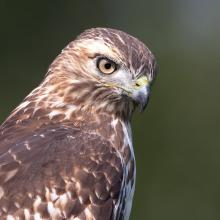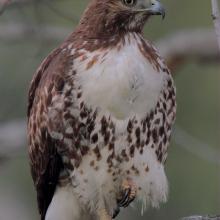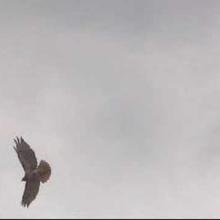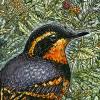

Join BirdNote tomorrow, November 30th!
Illustrator David Sibley and actor H. Jon Benjamin will face off in the bird illustration battle of the century during BirdNote's Year-end Celebration and Auction!
Bats and birds have evolved very different ways of flying. Birds have stiff feathers projecting from lightweight, fused arm and hand bones; bats have flexible wings of membranes stretched between elongated fingers. While birds use the strong downstroke of their wings to fly, bats support their weight on the upstroke, too, by twisting their wings backward. Bats tend to be more agile in flight, while many birds can fly with greater speed.
BirdNote®
Flying with Birds and Bats
Written by Bob Sundstrom
This is BirdNote.
[Forest Morning Songbirds]
In the long history of life on earth, vertebrates evolved powered flight just three times. Among reptiles, the now-extinct pterosaurs. Among mammals, the bats. And – of course – birds.
Bats and birds have evolved very different ways of flying. This starts with wing structure. A bird like the Red-tailed Hawk, for example, has stiff feathers projecting back from lightweight, fused arm and hand bones. The Big Brown Bats, found hunting for insects above many neighborhoods, have flexible wings of membranes stretched between elongated fingers.
[Bat sounds]
While the hawk uses the powerful downstroke of its wings to fly, the bat supports its weight on the upstroke as well, by twisting its wings backward.
[Bat sounds]
Bats appear to row through the air, flexing their wings like we use our hands to swim. They can fold their wings into different shapes to change direction suddenly to catch flying insects.
Although their agility in flight is no match for a bat’s, many birds fly with much greater speed. The hawk can flex its wings into a tight aerodynamic shape to swoop down on prey.
[Red-tailed Hawk call]
Both of these highly evolved groups of vertebrates have been very successful, and together prove there is more than one way to fly.
[Bat sounds]
For BirdNote, I’m Ariana Remmel.
###
Senior Producer: John Kessler
Content Director: Allison Wilson
Producer: Mark Bramhill
Associate Producer: Ellen Blackstone
Managing Producer: Conor Gearin
Bird sounds provided by The Macaulay Library of Natural Sounds at the Cornell Lab of Ornithology, Ithaca, New York. Red-tailed Hawk ML 47538 recorded by D. Herr.
BirdNote’s theme was composed and played by Nancy Rumbel and John Kessler.
© 2022 BirdNote February 2022/2024 Narrator: Ariana Remmel
ID# bats-05-2022-02-23 bats-05
References
https://www.researchgate.net/profile/L-Johansson/publication/6337140_Ba…
https://www.frontiersin.org/articles/10.3389/fphys.2020.01038/full
https://smallscience.hbcse.tifr.res.in/how-bats-fly/
https://www.google.com/amp/s/www.livescience.com/amp/1245-bats-efficien…









